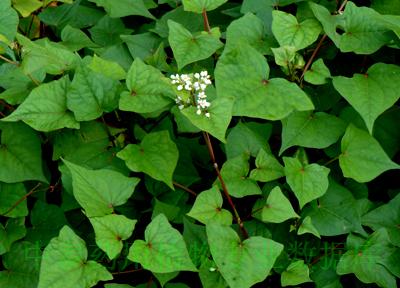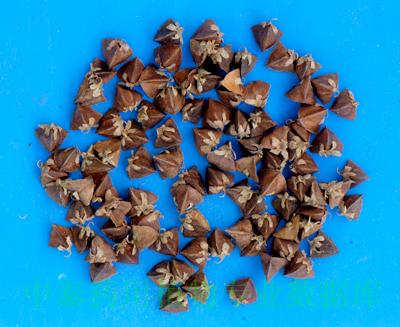| [English Name] | Wild Buckwheat Fruit | |
| [Chinese Name] | 荞麦 | |
| [Pinying Name] | Qiaomai | |
| [Latin Name] | Fagopyri Esculenti Fructus | |
| [Genera] | Polygonaceae | |
| [Efficacy] | xiaoshiyao | |
| [Pictures] | Plant picture | Drug picture |

|

|
|
| [Alias] | ||
| [Source] | ||
| [Plant morphology] | ||
| [Distribution] | ||
| [Gathering and processing] | ||
| [Characteristics] | ||
| [Ecology] | It prefers warm and wet,weakly cold resistance,is afraid of frost,poor ability of drought resistance. | |
| [Chemical composition] | ||
| [Pharmacological activities] |
1. Anti-oxidant: Polygonum convolvulus protein, sprout and total flavonoids extract can dose-effect relationship scavenge active oxygen, DPPH, hydroxy free radical[1,6,7,10,11]. 2. Anticancer: Recombinant trypsin can inhibit HL60 cell proliferation and induced apoptosis[2]. 3. Analgesia and Antiinflammatory: Water extract show analgesia and anti-inflammatory action on mice model[3]. 4. Hypoglycemic: Total flavonoids if seed and flower show hypoglycemic and blood fat, anti-lipid peroxidation[4,8]. 5. Hepatoprotection: Buckwheat total flavonoids show protect activity on acute liver injury induced by carbon tetrachloride[5,8]. Buckwheat polysaccharides show protect activity on acute liver injury induced by carbon tetrachloride and paracetamol[12]. 6.Cardioprotector: Flower total flavonoids show protect activity on myocardial hypertrophy induced by thyroxine[9]. 7. Lowering Blood Pressure: Buckwheat powder show lowering blood pressure on normal and spontaneously hypertensive rats[13,14]. 8. Other effects: Trypsin inhibitors can inhibit Alternaria alternate spores and mycelial growth[15]. Water extract can cure iron deficiency anemia[16]. |
|
| [Clinical trial] | ||
| [Properties] | ||
| [Medical and other Uses] | ||
| [Dosage] | ||
| [Cautions] | ||
| [Traditional usage] | ||
| [Toxicological studies] | ||
| [Pharmaceutical preparations] | ||
| [References] |
Pharmacologic Actions: [1] Zhang Meili, Zhao Guanghua, Hu Xiaosong. Acta Nutrimenta Sinica, 2005,27(1):21. [2],Gao Li, Li Yuying, Zhang Zheng. Journal of Experimental Hematology, 2007,15 (1):59. [3] Lin Hongmei, Han Shuying, Yi Xinduan. Journal of [4] Han Shuying, Lv Hua, Zhu Lisha. Chinese Pharmacological Bulletin, 2001,17(6):694. [5] Xin Nian, Xiong Jianxin, Han Shuying. Journal of [6] Qi Yajuan, Lin Hongmei, Han Shuying. Journal of [7] Zhang Zhiqiang, Liu Yetong, Qian Lili. Science and Technology of Cereals,oils and Foods, 2007,15(6):37. [8] Han Shuying, Zhang Baozhong, Zhu Lisha. Chinese Pharmacological Bulletin, 2003,19(4):477. [9] Shi Ruifang, Han Shuying. Journal of Chinese Medicinal Materials, 2006,29(3):269. [10] [11] Cao Wei, Song Jirong, Wei Yahui. Journal of Chinese Institute of Food Science and Technology, 2003,3(2):47. [12] Zeng Jing, Zhang Liming, Jiang Lixia. Pharmacology and Clinics of Chinese Materia Medica, 2005,21(5):29. [13]Choe. C A,1992,116: 172869v. [14]Suxuki. C A,1984, I00: 66746n. [15]Dunaevsky Y E. C A,1994, 121:104168U. [16] Zhou Lingxian. Journal of |
|